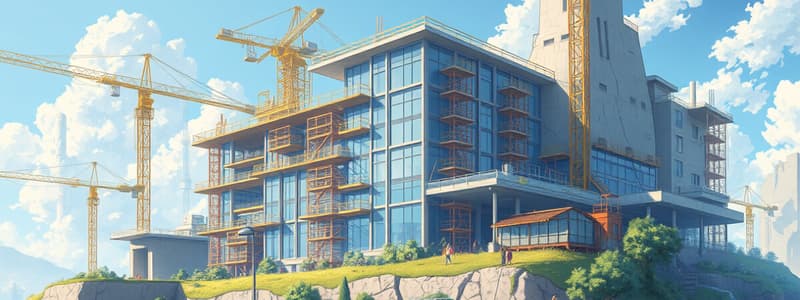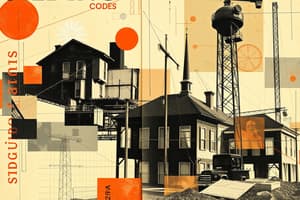Podcast
Questions and Answers
What types of construction are considered 'noncombustible'?
What types of construction are considered 'noncombustible'?
- I, II, III, IV
- III, IV
- III, IV, V
- I, II (correct)
Type III buildings are constructed with ______ exterior walls and interior elements __________.
Type III buildings are constructed with ______ exterior walls and interior elements __________.
noncombustible, of any material permitted by the code
A Type IV building is also described as _____ construction.
A Type IV building is also described as _____ construction.
- heavy timber (correct)
- combustible
- ordinary
- provincial
In buildings of Type III and IV construction, under what condition is fire-retardant-treated wood framing permitted within exterior wall assemblies?
In buildings of Type III and IV construction, under what condition is fire-retardant-treated wood framing permitted within exterior wall assemblies?
Where supporting floor loads, wood columns of Type IV construction shall be of what minimum nominal size?
Where supporting floor loads, wood columns of Type IV construction shall be of what minimum nominal size?
Where used in floor framing, wood beams of Type IV construction shall be of what minimum nominal size?
Where used in floor framing, wood beams of Type IV construction shall be of what minimum nominal size?
Roofs shall be without concealed spaces in buildings of Type _________ construction.
Roofs shall be without concealed spaces in buildings of Type _________ construction.
Which of the following materials is permitted in a building of Type VB construction?
Which of the following materials is permitted in a building of Type VB construction?
In a building of Type IB construction, what is the minimum required fire-resistance rating of the floor construction?
In a building of Type IB construction, what is the minimum required fire-resistance rating of the floor construction?
Which one of the following members is not considered to be a part of the primary structural frame?
Which one of the following members is not considered to be a part of the primary structural frame?
In a building of Type IIB construction, what is the minimum required fire-resistance rating of the roof construction?
In a building of Type IIB construction, what is the minimum required fire-resistance rating of the roof construction?
In a building of Type VA construction, which of the following building elements does not require a minimum 1-hour fire-resistance rating?
In a building of Type VA construction, which of the following building elements does not require a minimum 1-hour fire-resistance rating?
In a one-story Type IA building, what is the minimum required fire-resistance rating for the interior bearing walls supporting the roof only?
In a one-story Type IA building, what is the minimum required fire-resistance rating for the interior bearing walls supporting the roof only?
In Type IA buildings limited to two stories in height, what building element is permitted to be constructed of fire-retardant-treated wood?
In Type IA buildings limited to two stories in height, what building element is permitted to be constructed of fire-retardant-treated wood?
In a Type IB building housing a Group A-4 occupancy, fire protection of the roof structural members, framing and decking is not required where every portion of the roof construction is a minimum of ______ feet above the floor below.
In a Type IB building housing a Group A-4 occupancy, fire protection of the roof structural members, framing and decking is not required where every portion of the roof construction is a minimum of ______ feet above the floor below.
In a Type IIB building housing a Group I-2 occupancy, what is the minimum required rating for an exterior nonbearing wall located with a fire separation distance of 8 feet?
In a Type IIB building housing a Group I-2 occupancy, what is the minimum required rating for an exterior nonbearing wall located with a fire separation distance of 8 feet?
In a Type IIA building housing a Group R-2 occupancy, what is the minimum required rating for an exterior nonbearing wall located with a fire separation distance of 3 feet?
In a Type IIA building housing a Group R-2 occupancy, what is the minimum required rating for an exterior nonbearing wall located with a fire separation distance of 3 feet?
In a Type IIIA building housing a Group A-1 occupancy, what is the minimum required rating for an exterior bearing wall located with a fire separation distance of 10 feet?
In a Type IIIA building housing a Group A-1 occupancy, what is the minimum required rating for an exterior bearing wall located with a fire separation distance of 10 feet?
In a Type VB building housing a Group B occupancy, what is the minimum required rating for an exterior bearing wall located with a fire separation distance of 10 feet?
In a Type VB building housing a Group B occupancy, what is the minimum required rating for an exterior bearing wall located with a fire separation distance of 10 feet?
Considering all occupancies and construction types, for which minimum fire separation distance is not fire rating required for a nonbearing exterior wall?
Considering all occupancies and construction types, for which minimum fire separation distance is not fire rating required for a nonbearing exterior wall?
In a building of Type I or II construction, nonbearing partitions having a maximum fire-resistance rating of _______ are permitted to be constructed of fire-retardant-treated wood.
In a building of Type I or II construction, nonbearing partitions having a maximum fire-resistance rating of _______ are permitted to be constructed of fire-retardant-treated wood.
When used in Type IV construction, cross-laminated timber shall be a minimum of ______ inches in thickness.
When used in Type IV construction, cross-laminated timber shall be a minimum of ______ inches in thickness.
In a building of Type I or II construction, nonbearing exterior walls having a maximum fire-resistance rating of _______ are permitted to be constructed of fire-retardant-treated wood.
In a building of Type I or II construction, nonbearing exterior walls having a maximum fire-resistance rating of _______ are permitted to be constructed of fire-retardant-treated wood.
Show windows may be of combustible construction in Type I and II construction where located a maximum of _______ above grade.
Show windows may be of combustible construction in Type I and II construction where located a maximum of _______ above grade.
Which type of roof covering is not permitted on an office building of Type IIB construction?
Which type of roof covering is not permitted on an office building of Type IIB construction?
Which of the following methods of construction is not permitted for partitions in Type IV structures?
Which of the following methods of construction is not permitted for partitions in Type IV structures?
What is the minimum fire-resistive rating required for interior metal stud partitions in Type IIB construction?
What is the minimum fire-resistive rating required for interior metal stud partitions in Type IIB construction?
What is the minimum required vertical distance between the upper floor and the roof to allow the use of fire-retardant-treated wood in the roof construction of an eight-story Type IA building?
What is the minimum required vertical distance between the upper floor and the roof to allow the use of fire-retardant-treated wood in the roof construction of an eight-story Type IA building?
For an office building of Type IB construction, what is the minimum required fire-resistance rating for an exterior bearing wall located on an interior lot line?
For an office building of Type IB construction, what is the minimum required fire-resistance rating for an exterior bearing wall located on an interior lot line?
In a building of Type IIA construction, heavy timber members may be used in lieu of one-hour fire-resistance-rated construction for which building element?
In a building of Type IIA construction, heavy timber members may be used in lieu of one-hour fire-resistance-rated construction for which building element?
In a building of Type IV construction, 1-hour combustible construction is permitted in lieu of heavy-timber construction for which of the following building elements?
In a building of Type IV construction, 1-hour combustible construction is permitted in lieu of heavy-timber construction for which of the following building elements?
Where an exterior bearing wall of a Group M occupancy of Type IIB construction is located 3 feet from an interior lot line, the wall must have a minimum fire-resistance rating of hour(s).
Where an exterior bearing wall of a Group M occupancy of Type IIB construction is located 3 feet from an interior lot line, the wall must have a minimum fire-resistance rating of hour(s).
A nonbearing exterior wall of a Type IB open parking garage complying with Section 406 shall have a minimum fire-resistance rating of _______ hour(s) where the fire separation distance is 10 feet.
A nonbearing exterior wall of a Type IB open parking garage complying with Section 406 shall have a minimum fire-resistance rating of _______ hour(s) where the fire separation distance is 10 feet.
A glued-laminated beam, where utilized in a Type IV building requiring a 6-inch by 10-inch solid-sawn member of nominal size, shall have a minimum net finished size of _______.
A glued-laminated beam, where utilized in a Type IV building requiring a 6-inch by 10-inch solid-sawn member of nominal size, shall have a minimum net finished size of _______.
Under general conditions, thermal and acoustical insulation other than foam plastic is permitted to be installed in buildings of Type I or II construction, provided the insulation has a maximum flame spread index of _______.
Under general conditions, thermal and acoustical insulation other than foam plastic is permitted to be installed in buildings of Type I or II construction, provided the insulation has a maximum flame spread index of _______.
Flashcards are hidden until you start studying
Study Notes
Types of Construction
- Noncombustible construction types are classified as Type I and II.
- Type III buildings feature noncombustible exterior walls and allow interior elements of any material as permitted by the code.
- Type IV buildings are referred to as heavy timber construction.
Fire-Retardant Treatments and Ratings
- Fire-retardant-treated wood framing can be used in exterior wall assemblies for Types III and IV if the wall has a fire-resistance rating of 2 hours or less.
- In Type IV construction, wood columns must be a minimum nominal size of 8 inches by 8 inches to support floor loads.
- Roofs in Type IV buildings must not have concealed spaces.
Material Usage in Construction
- Type VB construction allows the use of wood, steel, and masonry.
- In a Type IB building, the minimum required fire-resistance rating of floor construction is 2 hours.
- For Type IIB constructions, the roof does not require any fire-resistance rating.
Fire Separation Distances
- Nonbearing exterior walls require no fire rating if the fire separation distance is 30 feet or more.
- For Type IIA buildings, exterior nonbearing walls must have a fire-resistance rating of 1 hour if located 3 feet from a fire separation line.
Specific Structural Requirements
- Interior metal stud partitions in Type IIB constructions require no fire-resistance rating.
- In Type IB buildings, the structural roof elements require no fire protection if 20 feet or more above the floor below.
- Heavy timber members in Type IIA construction can be used as an alternative to one-hour fire-resistance-rated roofs.
Construction Regulations
- Show windows in Type I and II constructions can be combustible if located no more than 15 feet above grade.
- Class D roof coverings are not permitted in office buildings of Type IIB construction.
Additional Notes on Sizes and Standards
- Cross-laminated timber must be a minimum of 4 inches thick in Type IV structures.
- The minimum required vertical distance between roof and upper floor to use fire-retardant-treated wood in roof construction of an eight-story Type IA building is 20 feet.
- Guled-laminated beams must meet specific size criteria to replace solid-sawn members in Type IV buildings.
Studying That Suits You
Use AI to generate personalized quizzes and flashcards to suit your learning preferences.



